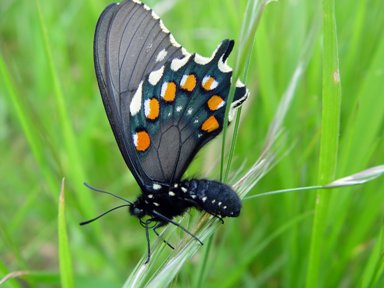Classification
"Butterflies....not quite birds, as they were not quite flowers, mysterious and fascinating as are all indeterminate creatures" - Elizabeth Goudge
Here is the classification of Battus philenor!
The Greek meaning of philenor is “fond of man/men” or “loving one’s husband” (bugguide.net)The word Battus comes from a "regal Greek family" from cyrene in North Africa (Tveten, 1996).The original combination of Battus philenor was Papilio philenor named by Linnaeus in 1771 (bugguide.net)
The common name for Battus philenor is Pipevine Swallowtail. Battus philenor received this common name because it can be found on Pipevine plants. To learn more about the diet of Battus philenor see Nutrition. The second part of the common name swallowtail refers to the tail like appendages on the hindwings of the butterfly (Hadley, Swallowtails)
"Domineering King Phillip Can Order Five Green Shirt"
Domain: Eukarya
Kingdom: Animalia
Phylum: Arthropoda
Class: Insecta (Hexapoda)
Order: Lepidoptera
Family: Papilionidea
Species: Battus
Genus: Battus philenor
Why Eukarya?
Battus philenor is in this Domain because of the
characteristics of Eukaryotes. Some of these characteristics include
large cells that have membrane-bound organelles with a true nucleus.
Eukaryotic cells may contain a cell wall if the organism is a plant
which is made from cellulose, but in animal cells there are no cell walls.
.jpg) The cells have complex functions such as dividing by mitosis and
meiosis. Some other organisms that are in this Domain include: dinoflagellates,
slime molds, and radiolarians. Image courtesy of Flickr. The picture
to the right shows ten species of radiolarians that are a part of the
Domain Eukarya.
The cells have complex functions such as dividing by mitosis and
meiosis. Some other organisms that are in this Domain include: dinoflagellates,
slime molds, and radiolarians. Image courtesy of Flickr. The picture
to the right shows ten species of radiolarians that are a part of the
Domain Eukarya.
Why Animalia?
Battus philenor is a part of the Kingdom Animalia because they
are herbivores, which means they get their energy by consuming autotrophs.
Organisms in the
Kingdom Animalia are multicellular and have no cell
walls. Since these organisms don’t have cell walls, their cells are
“flexible”. Another characteristic of the Kingdom Animalia is
locomotion, even though some organisms in this kingdom can be sessile.
Other organisms that are a part of this Kingdom are the
sponges, jellyfish, and
earthworms.
Image courtesy to Wikimedia Commons. The picture to the left shows a
Moon
Jellyfish (Aurelia aurita) which is a part of the Kingdom Animalia.
Why Arthropoda?
Organisms in this phylum are considered to be the most successful of the
entire animal phylums. Battus philenor is in the Phylum
Arthropoda because they possess tissues and are bilaterally symmetrical.
.jpg) Organisms of this phylum also have
a coelom and a chitinous exoskeleton.
They have segmented bodies with paired, jointed appendages. Other
organisms that are in this phylum include:
squids,
lobsters,
spiders and
scorpions.
Organisms of this phylum also have
a coelom and a chitinous exoskeleton.
They have segmented bodies with paired, jointed appendages. Other
organisms that are in this phylum include:
squids,
lobsters,
spiders and
scorpions.
Image courtesy of Wikimedia Commons. The image to the right is a picture of a Black Widow (Latrodectus mactans).
Why Insecta?
Battus philenor is in the Class.jpg) Insecta because the body of Battus philenor
is made up of a head, thorax and abdomen. Organisms in the class Insecta
have compound eyes with three pairs of legs. Organisms in this class may
have wings and undergo metamorphosis. The organisms in this class are also dioecious.
Dioecious means there are both male and female organsims. Some organisms
beside Battus philenor is this class are
dragonflies,
grasshoppers and flies.
Insecta because the body of Battus philenor
is made up of a head, thorax and abdomen. Organisms in the class Insecta
have compound eyes with three pairs of legs. Organisms in this class may
have wings and undergo metamorphosis. The organisms in this class are also dioecious.
Dioecious means there are both male and female organsims. Some organisms
beside Battus philenor is this class are
dragonflies,
grasshoppers and flies.
Image courtesy of Wikimedia Commons. The image to the left is of a Migrant Hawker dragonfly (Aeshna mixta).
Why Lepidoptera?
Battus philenor is in the Order Lepidoptera because it has
wings in pairs of two that are often unique and colorful (Hadley,
Swallowtails).
.jpg) Organisms in this
Order have large compound eyes and mouth parts that
are formed into a proboscis (Hadley,
Swallowtails). Organisms in the Lepidoptera
are moths and butterflies (Hadley, Swallowtails). A few other butterflies in the
Order Lepidoptera would be the Blue Morpho, and the monarch.
Organisms in this
Order have large compound eyes and mouth parts that
are formed into a proboscis (Hadley,
Swallowtails). Organisms in the Lepidoptera
are moths and butterflies (Hadley, Swallowtails). A few other butterflies in the
Order Lepidoptera would be the Blue Morpho, and the monarch.
Image courtesy of Wikimedia Commons. the picture to the right shows a monarch
butterfly (Danaus plexippus).
Why Papilionidea?
The Family Papilionidea consists of swallowtails and parnassians
(Reed, 2006). The swallowtails have a tail like feature on the hind wings.
The caterpillars in this family have an osmeterium, which is a fork-like
structure behind the head used for defense.
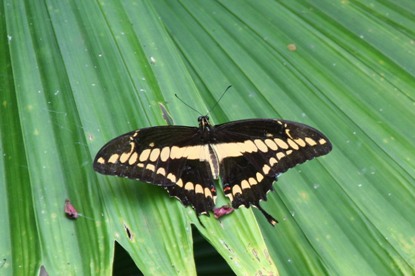 This family of butterflies
is different from the rest because the second anal vein on the adult
forewing extends to the wing margin and does not converge with the first
anal vein (Reed, 2006). Some organisms that belong in this family
include the Giant Swallowtail, and the Black Swallowtail.
This family of butterflies
is different from the rest because the second anal vein on the adult
forewing extends to the wing margin and does not converge with the first
anal vein (Reed, 2006). Some organisms that belong in this family
include the Giant Swallowtail, and the Black Swallowtail.
Image courtesy of Wikimedia Commons. The image to the left shows a Giant Swallowtial (Papilio cresphontes) which is apart of the family Papilionidea.
Why Battus?
The family Papilionidea is divided into three subfamilies; Baroniinae,
Parnassiinae and Papilioninae (Brower, 2005). The subfamily Papilioninae
is divided into three tribes which are Papilionini, Graphiini, and
Troidini (Brower, 2005). The Troidini is divided into twelve genera, one
which is the Genus Battus.
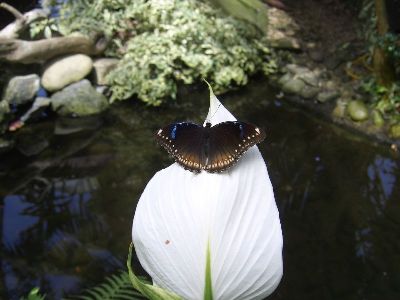 There are 11 species in the genus
Battus (Brower, 2005). Battus is
regarded as the most primitive genus within the tribe Troidini.
Organisms in this genus use plants in the Family Aristolochiaceae for
their host plant. Other species that are in the Genus battus include the
Battus belus (Belus Swallowtial) or the Battus crassus
(Crassus Swallowtail).
There are 11 species in the genus
Battus (Brower, 2005). Battus is
regarded as the most primitive genus within the tribe Troidini.
Organisms in this genus use plants in the Family Aristolochiaceae for
their host plant. Other species that are in the Genus battus include the
Battus belus (Belus Swallowtial) or the Battus crassus
(Crassus Swallowtail).
Image courtesy to Wikimedia Commons. The image to the right shows Battus
polydamas which is part of the Genus Battus.
Why Battus philenor?
Battus philenor only lay eggs on plants in the Family
Aristolochiaceae. They have a wing span of 3-5cm.
.jpg) There
are black
and blue-green iridescence on the upperside of the hindwing. The upperside of the
hindwing also has a row of seven large round orange spots ringed with black (Tveten,
1996).
A row of white dots on the wings separate the male and female. The forewings
of Battus philenor are
generally dark in color. The larvae are either black or red depending on
the environment. Battus
philenor contain compounds from the host plant that make them
distasteful and deadly to predators
There
are black
and blue-green iridescence on the upperside of the hindwing. The upperside of the
hindwing also has a row of seven large round orange spots ringed with black (Tveten,
1996).
A row of white dots on the wings separate the male and female. The forewings
of Battus philenor are
generally dark in color. The larvae are either black or red depending on
the environment. Battus
philenor contain compounds from the host plant that make them
distasteful and deadly to predators
Image courtesy of Wikimedia Commons. The image to the left shows the Battus philenor feeding from a flower.
Phylogeny
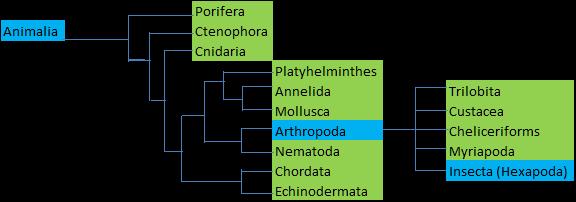
The image above is modified from Biology: Eighth Edition published
by Campbell Reece. The phylogenetic tree above is based on the tissue type the
organism has. As you can see from the tree the Phylum Arthropoda is
closely related to the Phylum Nematoda.
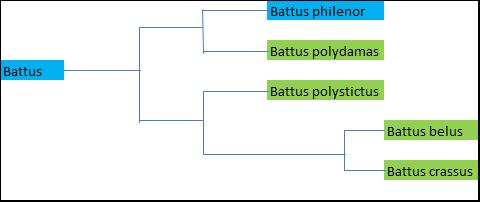
The tree above is modified from the article Phylogenetic Relationships
of the New World Troidini Swallowtails (Lepidoptera: Papilionidea) based
on COI, COII. and EF-1α genes. The phylogenetic tree above is based
on the optimization of ecological and morphological traits of the
phylogeny of Trioidini (Battus is one of twelve genus that make up the
tribe) (Brower, 2005).
To continue learning about Battus philenor go to the Habitat page.
.jpg)
.jpg)
